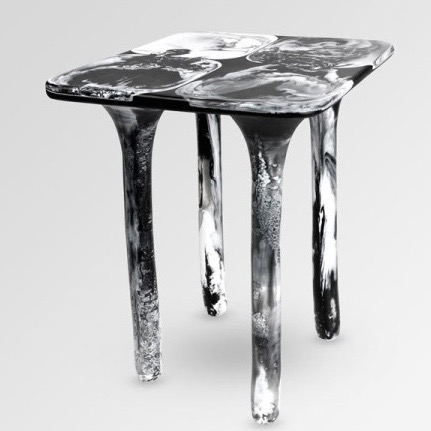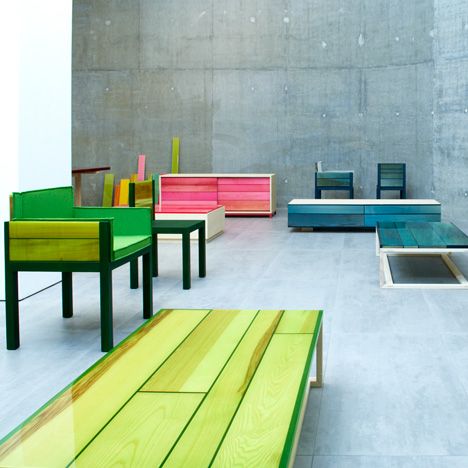As a teenager I made cast resin skateboard decks and even managed to make a pretty reasonable surfboard, so resin has always been a bit of a fascination of mine. I am constantly excited by the ways artists and craftspeople are using the clear viscous material – either cast into poetic shapes or allowed to flow over objects and surfaces preserving their appearance, creating a window to what lies beneath.
Two names spring immediately to mind when talking about resin in home wares. One is the Australian studio Dinosaur Designs who started working in resin in the mid eighties. These days headed up by two of the three founders, Louise Olsen and Stephen Ormondy, the studio and brand has stand alone shops in London, New York. Melbourne, Sydney and Brisbane.
While best known for their chunky resin jewellery pieces, they have been making home accessories like bowls, vases, salad servers and pepper grinders for a couple of decades and recently launched a collection of stools.
The style is generally soft, rounded and organic but on occasions certain collections have featured bold graphic qualities - an indicator of the founders' interest in artists like Victor Vasarely and Bridget Riley along with designers who explored resin such as Gaetano Pesce.
The other long term player in this medium is Martha Sturdy, the Canadian designer who has been working in resin since the late 70’s. Sturdy, like Dinosaur Designs, produces a large range of bowls and vases but has extended her offering to include a considerable amount of furniture.
Usually cast around a metal framework to ensure it is strong enough to support the human body, Sturdy’s furniture pieces rely on the swirling mix of opaque and clear resin to project visual lightness even when the product is actually extremely heavy. At Maison & Objet recently she showed a range of predominantly white tables, stools and benches that continue to reveal her preference for simple minimal shapes based around cubes and cylinders.
While resin might be considered the poor cousin of glass by some, the fact remains that it is a material that is easy to manipulate and because it doesn’t need to be molten to pour, can achieve many things that are impossible in glass. Some designers such as Shiro Kuramata have used acrylic resin to replicate the highly transparent nature of glass while allowing the submersion of foreign objects like coins or in the case of Kuramata, plastic flowers.
But while this more high-tech, industrialised use of resin can be quite mesmerizing, it’s the more handcrafted pieces that many find more appealing. The simple fact that resin can be poured onto surfaces or into moulds in a fairly low-tech studio environment means it is well suited to all manner of experimental concepts. Italian collective Nucleo are constantly creating new projects which feature resin as the key material – sometimes to halt the aging process and ‘souvenir’ an object or to create new forms that crystallise its special qualities - particularly in relation to light, colour and shape.
The Turin based group led by Piergiorgio Robino have produced one-off and limited edition pieces since the early 2000’s and are represented by Gabrielle Ammann Gallery in Germany, Nilufar Gallery in Milan, Galerie Italienne, in Paris and Galleria N°38 in Lucca.
"We play with the presumption of interlacing time-frames and exploring the space they create. With a focus on three dimensional shapes, the physical and tactile experience is an important part of the expression. We have always been interested in working with history, the lack of history, and the creation of it. Aspects necessary to build a memory. We believe that through making a past of the future, we can create a curiosity of history that has not yet happened”. From the Nucleo artist statement.
Alcoral (Andrea Forti and Eleanora Dal Farra) is another Italian studio who have explored the properties of resin at length. Based between the lagoon of Venice and the Dolomite mountains, the studio references nature extensively in their work, trapping miniature plants that grow on rocks in their local area or preserving the decayed state of ancient Gondolar poles (known as briccole) within resin.
‘Dolomyth’ is a project where blocks of pink stone from an abandoned quarry in the Dolomite mountains are extracted with living lichen and moss still clinging to them. The blocks are then precision cut and polished while the naturally irregular top surface and living organisms are totally encased in resin. Part biology specimen, part art installation, 'Dolomyth' is a fascinating example of the use of resin.
While physically very different, the studio's recent work 'Marbleways', first presented by Mint Gallery at London Design Festival in 2015, also draws on discarded elements from the marble industry. The ‘Marbleways’ collection consists of tables and benches made from the timber used in mechanized marble cutting.
The blades run back and forth cutting slabs into the required shapes, scoring random grooves in the timbers surface. Because of the water used to lubricate the saw blades, marble dust is forced into the pores of the timber and a subtle pigment is added to the wood grain. Capturing the result of this with clear resin provides a unique plaid pattern with a smooth outer surface.
Working in a similar vein, Japanese architect and designer, Jo Nagasaka of Schemata Architecture Office, first presented his antique tables ‘repaired’ with resin in 2009. In these pieces worn tops or broken parts were encased in resin to make up for the original materials shortcomings or failings. In later projects such as the ‘Flat-Table-Peeled’ collection shown at Rossana Orlandi in Milan in 2011, Nagasaka removed the edge bark from douglas fir boards before repairing the edge and surface irregularities in fluorescent pink and green resin.
From these limited edition collections Nagasaka was commissioned by Established & Sons to create a production collection using similar techniques and in 2013 the British company launched the ‘Udukuri’ table, ‘Uri’ sideboards and ‘Uri’ low tables.
Seoul-born Wonmin Park is an artist who prefers to work in solid resin without any binders or reinforcing agents. His solid slabs of resin have a hazy translucent quality whether in subtle sorbet colours or back and white.
His simple geometric objects are all based on furniture archetypes but are more sculptural pieces rather than being designed for everyday use. Park was a student at Design Academy Eindhoven where he graduated in 2011 starting his own studio immediately after and exhibiting his first collection at Design Days Dubai and Design Miami in 2013 to much acclaim.
He now has a production facility in Rotterdam and a studio in Paris and will be showing his work as part of the Wallpaper* Handmade exhibition in Milan in April 2016 and in a solo show at Carpenters Workshop Gallery London.
London-based Polish designer Marcin Rusak grew up in a family of flower growers. His fascination with flowers is evident in much of his work but the medium in which he expresses it varies. In 2014 he completed a MA at the Royal College of Art London and showed his ‘Flora’ range of objects as part of the Future Heritage exhibition at Decorex London in September 2015. This collection won him the Perrier-Jouët Arts Salon Prize for 2015 and he has subsequently won a Wallpaper* Design Award for the ‘Flora’ pieces.
Each of the three items is a unique piece involving the submersion of specially treated and dried flowers into a black resin compound developed for the project. The flowers retain their colour and form within the resin capturing the fleeting moment before flowers wither and turn brown. While the three pieces use a similar concept the method of making is different for each.
The ‘Flora’ table is made from sand cast aluminium with a cast slab top that is cut and polished to reveal the flowers near the surface as if looking into a deep, dark pool of water. The ‘Flora’ screen is made up of a multitude of thin strips cut from a large block of resin heavily laced with flowers. The cut strips are then arranged in vertical and horizontal strips within a patinated brass frame. The final piece, the Flora lamp is a highly functional design piece where the base and counterweight components are made from cylinders of Rusak’s flower encased resin that appears in this instance to be more like an unusual form of stone.
Wiktoria Szawiel, a recent graduate of Design Academy Eindhoven works with resin, wicker and rattan to produce well-known forms with a new ethereal quality. Choosing to use a more opaque form of resin tinted a milky white, Szawiel’s objects loom out from their encased state, surprising the viewer by their delicate and sometimes highly damaged state. Rather than preserving ancient materials as some other artists do, Szawiel prefers to fossilize everyday objects and simple fibres.
Co-founded by Japanese architect Azusa Murakami and English artist Alexander Groves, Studio Swine uses intensive research to establish the guiding principles of each of its projects and documents the process with films with such high production values that they have aired on the National Geographic and the Discovery channels and even won an award at Cannes.
The studio were recently awarded with the prestigious Designer of the Future award by Swarovski at Design Miami/ Basel which recognises outstanding young talent in design. Their Hair Highway project, involved the development of a type of resin which included carefully placed human hair to became highly decorative. The collection was one of the most acclaimed projects shown at Design Miami/ Basel 2014 and ranged from a dressing table piece down to smaller objects like vases, combs and bracelets. The background to the project was the hair trade that goes on in Asia and the fact that hair is an under utilised commodity given it grows 16 times faster than hardwood. The project took the Shanghai deco style of the 1930’s as it’s key stylistic driver and the results were spectacularly beautiful.
For some extraordinarily beautiful films, not only on the Hair Highway project but also on other projects by Studio Swine that creatively look at recycling plastic sea debris and aluminium cans, please click here.
































